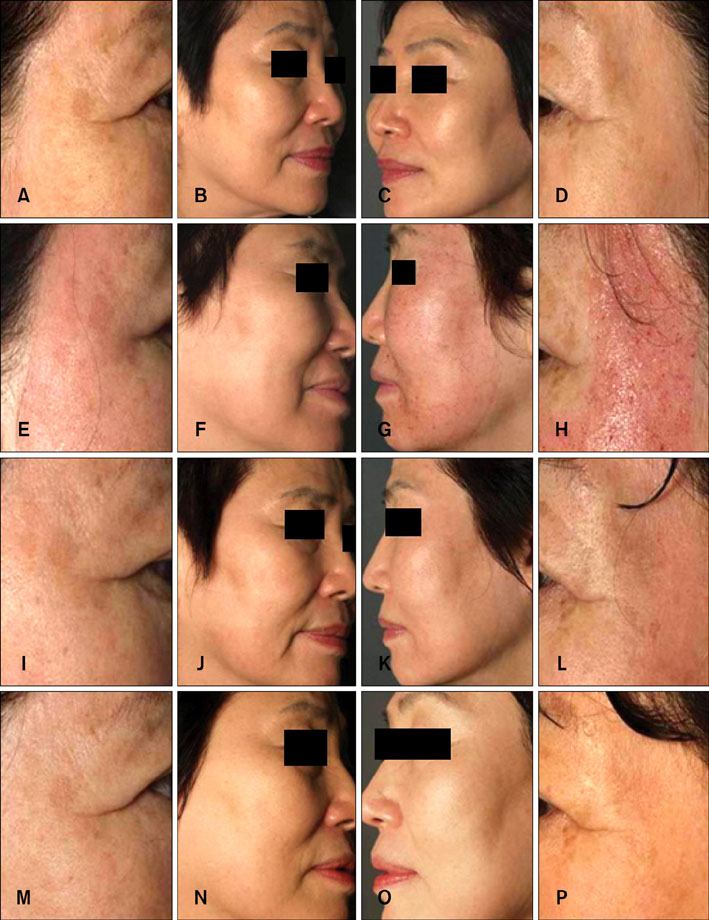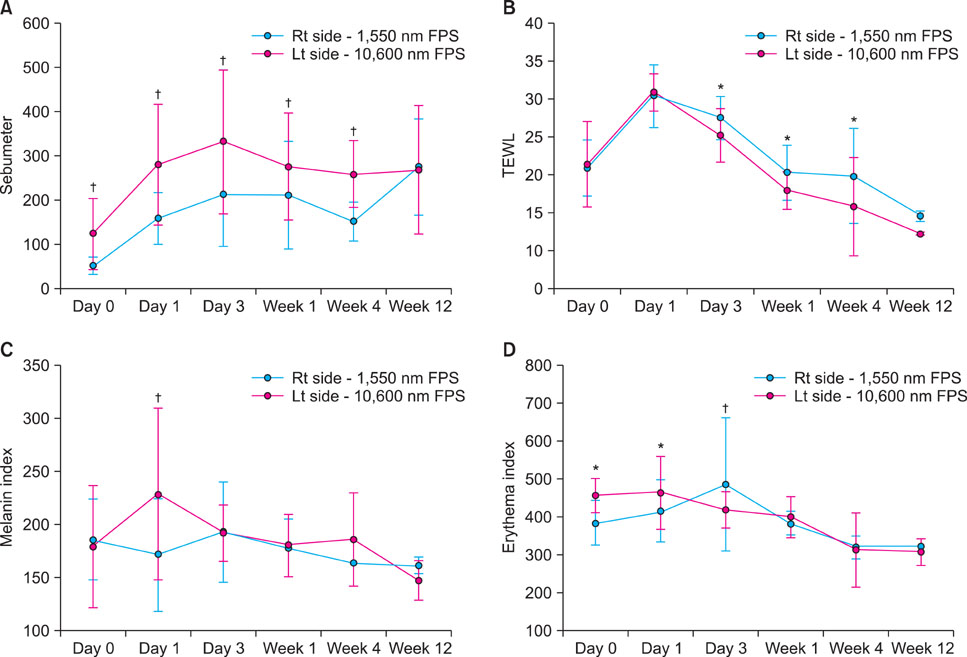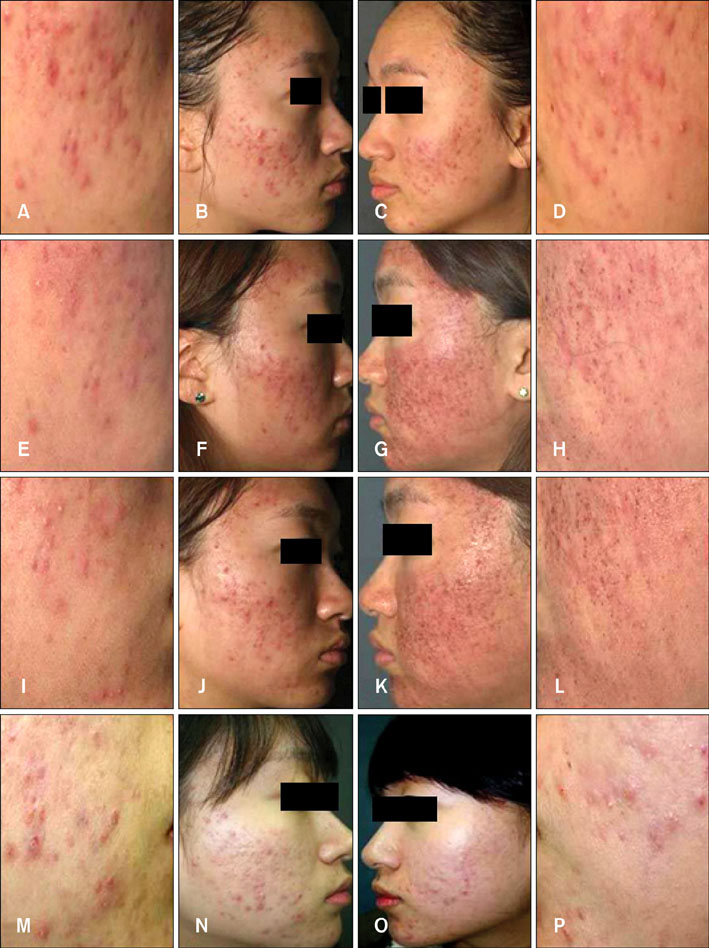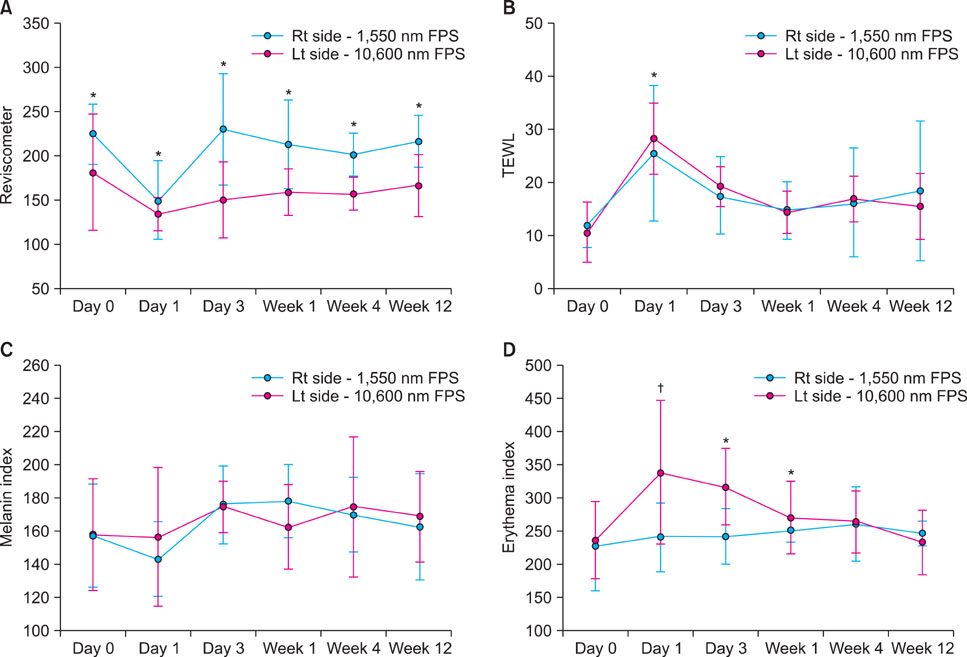Ann Dermatol.
2011 Nov;23(4):448-454.
Skin Characteristics after Fractional Photothermolysis
- Affiliations
-
- 1Department of Dermatology, Konkuk University School of Medicine, Seoul, Korea. 20050078@kuh.ac.kr
Abstract
- BACKGROUND
Fractional photothermolysis makes thousands of minute areas called microthermal treatment zones on the skin surface and transmits thermal injury to facilitate heat shock protein formation around the dermis. Potential side effects include acneiform eruption, herpes simplex virus outbreak, erythema, and post-inflammatory hyperpigmentation.
OBJECTIVE
To investigate and compare the changes in the skin of Asian patients after two different fractional photothermolysis systems (FPS) on a split face.
METHODS
A half-split face study was performed with 10,600 nm carbon dioxide FPS on the left and 1,550 nm erbium-doped FPS on the right side of the face. Only one session of laser irradiation and several biophysical measurements were done.
RESULTS
Although both FPS proved to be effective in treating acne scar and wrinkle patients, a slightly higher satisfaction rating was seen with the 10,600 nm FPS treatment. Both types of FPS showed a significant increase in transepidermal water loss which decreased gradually after treatment and returned to pre-treatment level after 1 week. A decreased reviscometer score was sustained for a longer period in wrinkle areas treated with 10,600 nm FPS.
CONCLUSION
Even though the changes in skin varied according to different FPS wave-length, adverse outcomes, such as increased erythema and TEWL were entirely subdued within 3 months of treatment.
Keyword
MeSH Terms
Figure
Reference
-
1. Yasui T, Takahashi Y, Fukushima S, Ogura Y, Yamashita T, Kuwahara T, et al. Observation of dermal collagen fiber in wrinkled skin using polarization-resolved second-harmonic-generation microscopy. Opt Express. 2009. 17:912–923.
Article2. Layton AM, Henderson CA, Cunliffe WJ. A clinical evaluation of acne scarring and its incidence. Clin Exp Dermatol. 1994. 19:303–308.
Article3. Goodman GJ. Postacne scarring: a review of its pathophysiology and treatment. Dermatol Surg. 2000. 26:857–871.
Article4. Hasegawa T, Matsukura T, Mizuno Y, Suga Y, Ogawa H, Ikeda S. Clinical trial of a laser device called fractional photothermolysis system for acne scars. J Dermatol. 2006. 33:623–627.
Article5. Chan HH, Lam LK, Wong DS, Kono T, Trendell-Smith N. Use of 1,320 nm Nd:YAG laser for wrinkle reduction and the treatment of atrophic acne scarring in Asians. Lasers Surg Med. 2004. 34:98–103.
Article6. Manstein D, Herron GS, Sink RK, Tanner H, Anderson RR. Fractional photothermolysis: a new concept for cutaneous remodeling using microscopic patterns of thermal injury. Lasers Surg Med. 2004. 34:426–438.
Article7. Layton AM. Optimal management of acne to prevent scarring and psychological sequelae. Am J Clin Dermatol. 2001. 2:135–141.
Article8. Day DJ, Littler CM, Swift RW, Gottlieb S. The wrinkle severity rating scale: a validation study. Am J Clin Dermatol. 2004. 5:49–52.9. Goodman GJ, Baron JA. The management of postacne scarring. Dermatol Surg. 2007. 33:1175–1188.
Article10. Gomella LG, Haist SA. Pain management. Clinician's Pocket Reference. 2007. 11th ed. New York: McGraw-Hill;323–340.11. Morgan GE, Mikhail MS, Murray MJ. Clinical anesthesiology. 2005. 4th ed. New York: McGraw-Hill;359–412.12. Tannous Z. Fractional resurfacing. Clin Dermatol. 2007. 25:480–486.
Article13. Hantash BM, Bedi VP, Kapadia B, Rahman Z, Jiang K, Tanner H, et al. In vivo histological evaluation of a novel ablative fractional resurfacing device. Lasers Surg Med. 2007. 39:96–107.
Article14. Hantash BM, Bedi VP, Chan KF, Zachary CB. Ex vivo histological characterization of a novel ablative fractional resurfacing device. Lasers Surg Med. 2007. 39:87–95.
Article15. Graber EM, Tanzi EL, Alster TS. Side effects and complications of fractional laser photothermolysis: experience with 961 treatments. Dermatol Surg. 2008. 34:301–305.
Article16. Setyadi HG, Jacobs AA, Markus RF. Infectious complications after nonablative fractional resurfacing treatment. Dermatol Surg. 2008. 34:1595–1598.
Article
- Full Text Links
- Actions
-
Cited
- CITED
-
- Close
- Share
- Similar articles
-
- Usefulness of Skin Explants for Histologic Analysis after Fractional Photothermolysis
- Fractional Photothermolysis for Treatment of a Residual Discoid Lupus Erythematosus Lesion: A Case Report
- Treatment of Acne Scars and Wrinkles in Asian Patients Using Carbon-Dioxide Fractional Laser Resurfacing: Its Effects on Skin Biophysical Profiles
- The Consideration of Dermoscopic Findings during Atrophic Acne Scar Treatment: a Pilot Study
- Treatment of Striae Distensae with Nonablative Fractional Laser versus Ablative CO2 Fractional Laser: A Randomized Controlled Trial





